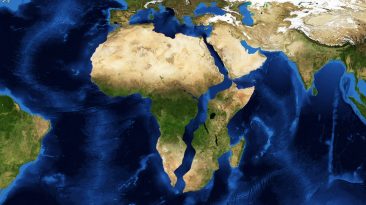We’ve come a long way since then. All planets are round but have you ever wondered why? Let’s go back in time, to 4.5 billion years ago. A big cloud of gas and dust, called a nebula, collapsed to form a hot star which, through its gravitational pull, attracted all nearby matter, and formed a large rotating disk around its center.
After more than just a few collisions, the matter orbiting the young sun evenutally grew into massive bodies, with strong gravitational centers. They formed planets. On any given planet, gravity pulls equally from all sides towards its center. This accounts for their spherical shape.
So because the Earth we live on is a sphere, and its gravitational pull is the same wherever you go, it means that as long as you’re on a flat surface, you’ll be standing straight and tall. But what do you think happens when you skew the distribution of gravity?
So you want to live life on the edge? Then pick a side! The Earth has six faces now, but sadly, none of them are any fun. That’s because anywhere you go is going to feel like you’re climbing up a steep hill.
[dx_custom_adunit desktop_id=”RTK_CDE4″ mobile_id=”RTK_SUFd”]
On the cubed Earth, gravity is strongest at the center of each of its faces, so the further you are away from the center, the more you’ll feel its pull.
Hope you didn’t take standing tall for granted! The landscape along the Earth’s edges would be rocky and barren, since all the water would be pooled at the center of each face. And the atmospheric quality along the Earth’s edges and corners would be too thin – or non-existent – to support life. We’ll come back to that later.
The new climate would depend on how the Earth rotates. If our cubed planet rotated on an axis through two of its faces, then the climate would be kind of how it is right now on Earth, only more extreme. The top and the bottom faces would be polar, while the remaing four sides would enjoy an equatorial climate.
However, if the Earth was a cube that rotated through its corners, then each side would have a temperate climate, you could say good bye to extreme temperatures and precipitation. Sadly, that means saying good bye to your equatorial fantasy world too. On the plus side, you might just be able to walk into outer space.
Since our atmosphere is held down by gravity, and since gravity is now pulling from the center of each of Earth’s faces, it means that the atmosphere would be thicker where gravity is strongest, and thinner towards the edges. What’s more, if the cubic Earth had the same volume as our rounded world today, then its sharp, steep corners would actually poke out beyond our atmosphere. These areas would be unprotected, and therefore uninhabitable, but who says you couldn’t rent a space suit and stand on top of the world and outside of it at the same time?
What would we call ourselves on this six-sided Earth? Cubists? Cubans? We’ll never find out, and that’s probably for the best.
Subscribe to What-If on Youtube or follow the show on Facebook Watch.
Sources
- How big is Earth?
- How would the weather on Earth be different if it were a cube?
- How far is the atmosphere from Earth?
- The Temperate Climate
- How was our Sun formed?
- How do our planets form?
- Round Planets
- What is Gravity?
- The Cubical Planet
- What is the cube Earth hypothesis?
- What if the Earth was a Cube?
- What If Earth Was A Cube?
- Do you see different phases of the Moon around the world?
- The lost world of Aocicinori, circa 1960
- Atmosphere of Earth
- Protostar



























